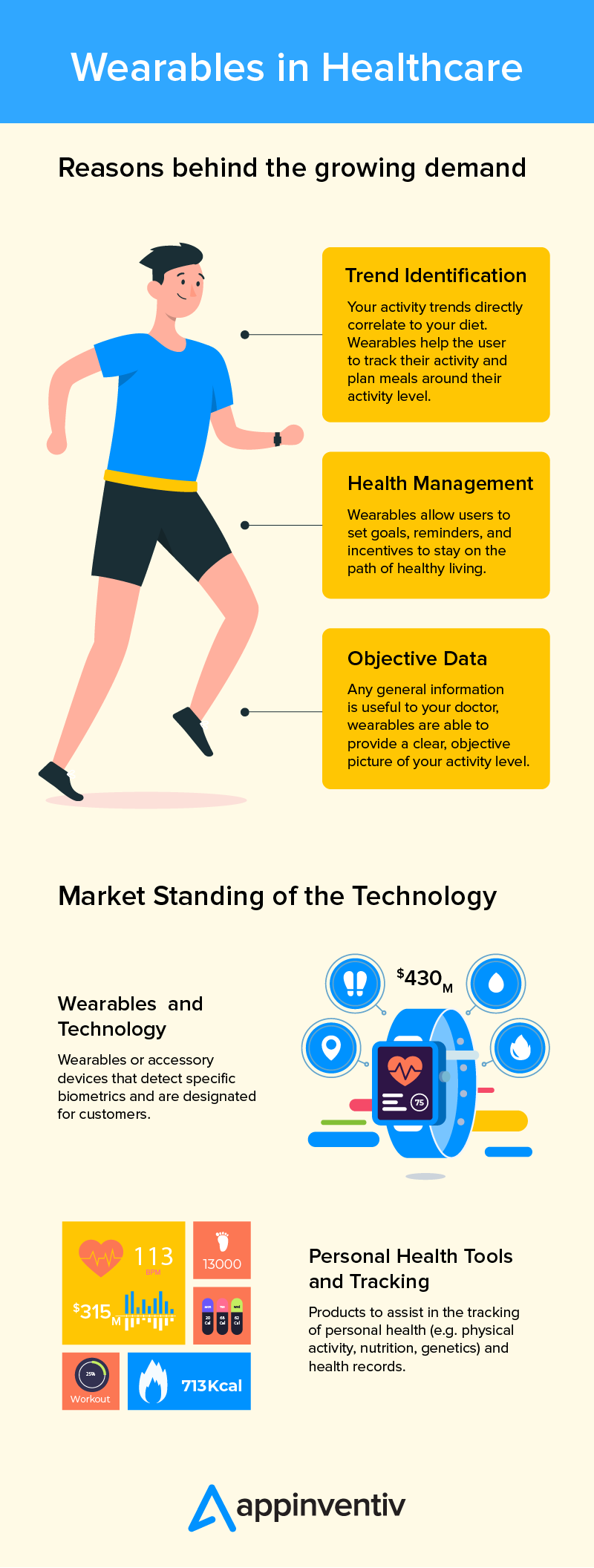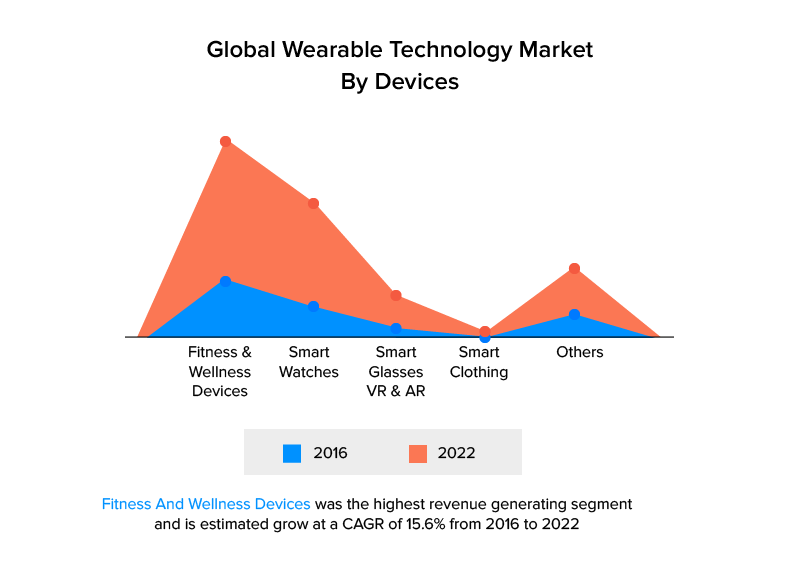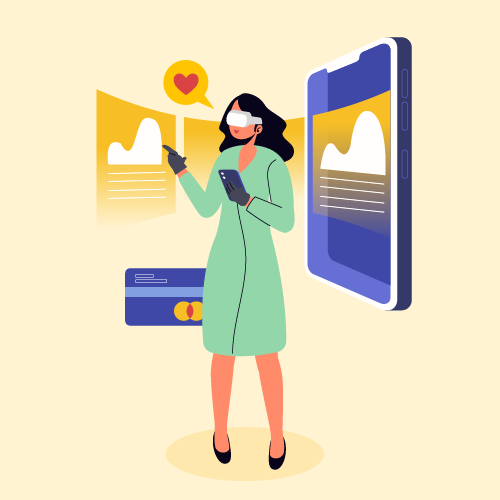VR and Wearables: Transformative Technologies in Healthcare Industry
Changes in Healthcare since the last 10 years has been one of the most transformative ones. The industry that was once restricted between the doctors and patients, now has a third lim chjb attached to it, and that’s– Technology.
While technology had already found its place in the domain at the medicine and operative level, now the impact of technology in the healthcare market at the patients’ level is large.
Today, with the growing demand for greater control in patients’ hands, the industry has attracted two of our time’s most disruptive technologies within, that is wearable technology in healthcare and virtual reality in healthcare.
Both the technologies, while being impactful, are enabling themselves to create a greater presence and impact in the life of patients and doctors by partnering with devices that are always with them. With Wearables, AR, and VR, the fitness industry is gamified and the healthcare industry is getting transformed to provide various benefits to the users. It is becoming an integral part of users’ home screens, smartphones, and smart watches when mixed with transformative technologies. Also the technology of Mixed Reality is cementing its base in medical science through its various advantages and uses, which you can read here.
Benefits of VR in Healthcare sector
Medical experts are using VR-empowered gadgets for less expensive and effective technology to analyze, treat, and cure advanced diseases, and so forth.
Measuring the developing demand and request of VR in medical care, specialists foresee this industry to reach $5.1 billion constantly 2025.
Let us know how the benefits of virtual reality in healthcare and augmented reality are making their presence in the medical care area:
- In dental consideration, experts utilize a 3D IOS scanning framework to create dental projections. This is particularly useful in anticipating dental surgical intervention.
- VR upholds handheld innovation that can be accessed through a hand-held scanner. This is helpful in conveying spatial data in a mobile format.
- A mix of AR and VR has created incomprehensible outcomes in medical services. For instance, health experts use AR to project a virtual brain on the head of the patient. Simultaneously, VR causes the patient to have real-time involvement with the projection and witness the arrangements being applied.
- VR innovation has helped in building up a wheelchair navigation system with the use of smartphones. It scans the areas to help patients to move in the particular environment easily.

Let us now take a sneak peek into the most talked about two technologies that have already started changing the Healthcare outlook and where mobile apps fit in between. And why it’s time for the medical app development companies to gear up and prepare themselves for the demand that will flow in for implementation of both the technologies in the mHealth Apps.
1. Role of VR in Healthcare Industry

The inception of Virtual Reality the healthcare industry has become a flourishing scenario, which offers unlimited opportunities for a number of companies. Inspite of the fact that the speediest growth in the domain is backed by the high demand for VR based video games and entertainment share, a massive share is held by the healthcare industry.
VR technology is fast improving the healthcare sector in many ways. VR in the healthcare industry has already been used for treatment planning, diagnostics, training of surgeons etc. Above all, it is now being used for curing severe conditions like phobias, depression, autism, PTSD, and addictions. According to the Global Industry Analysts, the global market of Virtual Reality solutions operating in the healthcare domain is forecasted to go up by $3.8 Billion by 2020.
Now that you know how big the VR market is going to be in the Healthcare industry let us look at how the industry is using the technology.
Relief and Treatment
A virtual reality environment can be utilized to help patients with their pain reduction and improvement of sleep habits.
With VR one can use a specific environment to treat mental conditions of patients, such as anxiety, phobias, and addictions, etc. VR Healthcare Simulation of events helps to recognize the disorder patterns and likewise develop treatment strategies that are efficient.
2. Applications of VR in Healthcare
Practice Medical Processes without Getting Inside a Body
Doctors and nurses generally used to practice medical processes (all – something as small as putting on anesthesia or something as complex as leg amputation) on mannequins and bodies from their morgue room.
With VR, the times are now changing. With VR based mobile apps like Touch Surgery, the practitioners now practice the processes on Virtual Humans, giving them a chance to know what exactly goes inside a body when a process is initiated, without even getting inside a body. This form of virtual simulation also helps with increasing the precision and in reducing the complications & trauma.
Lowering PTSD Occurrences
VR has come as a major relief technology for people who suffer from anxiety and patients with severe cases of PTSD. By either taking them to the point of war to help them move on or by introducing them to a peaceful virtual world, VR has been a boon in lowering stress levels of patients.
There are a number of mobile apps in both Android and Apple stores, such as Relax VR, Zen Zone, and Monarch VR, etc. that are developed on the foundation of Virtual Reality, which are targeting especially PTSD patients or the ones that suffer from other forms of anxiety disorders.
Pain Management
Doctors are now using VR based mobile apps to help their patients cope with pain. There are a number of apps, which take the patients in a soothing environment when they are going through a painful medical procedure.
These VR apps have been able to reduce the usage of painkiller drugs, helping in improving the overall health by lowering the health risks associated with heavy medication consumption.
While these are just the three applications of virtual reality healthcare, there are a number of other ways the medicine industry is transforming by introducing everyone involved to a safe, practice world.
It is because of VR’s growing use cases, that the technology is now penetrating itself in the Healthcare industry. Now the need of the hour is involved VR App Development Companies to make the coping, disruptive technology available to the masses.
Next to Virtual Reality, wearable devices in healthcare is another element that holds the potential to change the healthcare domain. Let us throw some light on how and where wearable fit in in the health and care industry.
3. Role of Wearable in Healthcare

Gone is the time when wearable was only restricted to monitoring the number of steps a user had taken in a day or how much more calories he needed to burn tomorrow. Today, the future of wearable technology in healthcare has moved ahead of their original lifestyle tracking purposes to create a more in-depth impact on users’ health.
Brands are now investing in the wearable industry and healthcare app development services to cater the healthcare domain to not just draw learnings from patients’ insights but also to infiltrate themselves in the physical and mental wellbeing scenario of the million users the healthcare domain comes with.
With the support of millions of investment, from a single healthcare app development company to many are planning to increase the number of sensors present in the wearables from now few to hundreds in the coming time. This will help them track and then take responsive monitored action, depending on the user’s conditions.
Let us look at how the industry will move beyond lifestyle tracking and technicalizing the age-old healthcare domain –
4. Use Cases of Wearables in Healthcare

Here are some ways wearable devices in healthcare will make its place in the medical industry in the coming time.
Health Monitoring
Wearable technology in healthcare has become a very convenient way to track a patient’s health. There are now a number of medical grade wearable devices in healthcare that not only help monitor but also treat and rehabilitate chronic diseases.
Post-Operative Care
Body sensors are emerging as one of the largest wearable devices’ categories of the coming time. By being placed inside or on the body, they can help track a number of conditions like blood pressure, heart functioning, gastric stimulation, etc.
Whether inside the body or out, the applications of wearables in healthcare have become a medium for doctors to keep a track on and check their patients, when needed. When connected with an integrated mobile app, patients themselves can keep track of their body temperature, heart rate, and even stress level.
So, here were some of the ways where the benefits of wearable technology in healthcare are already impacting/ soon to impact the technology domain in the healthcare industry. The prerequisite of wearables’ mass adoption is involving wearable app development companies in the cycle. Until you connect the wearables to the device that is viewed and used all the time, you will never be able to monitor what your vitals are showing you.
And even then, what do you do with that information? Now that you have a set of data that you have generated from all your wearable devices, what next?
The next step that follows, introduces Data Analysis to the Picture.
5. Role of Data Analytics in Healthcare Wearable
Monitoring key metrics presented by patients’ wearable is not enough. Doctors will also need a platform where they can store and analyze all the collected data. These generated data when mixed with AI, can help in providing next steps to the patients.
We developed a mobile app to bring the consolidated data of all the wearable devices a user owns in one place, for comprehensive monitoring – Health ePeople.
The wide spreading application of these two technologies is just the beginning. With the ever-growing need of timely, personalized, ahead of time, and cost-effective medical practices, the industry is all set to witness more and more technologies getting invented just to fulfill the demand.
For now, if you are looking to make your Healthcare Mobile App aligned with the technologies that would change the look of the Healthcare system itself, Contact Our Team of mHealth App Experts, Today.

strategies your digital product..



